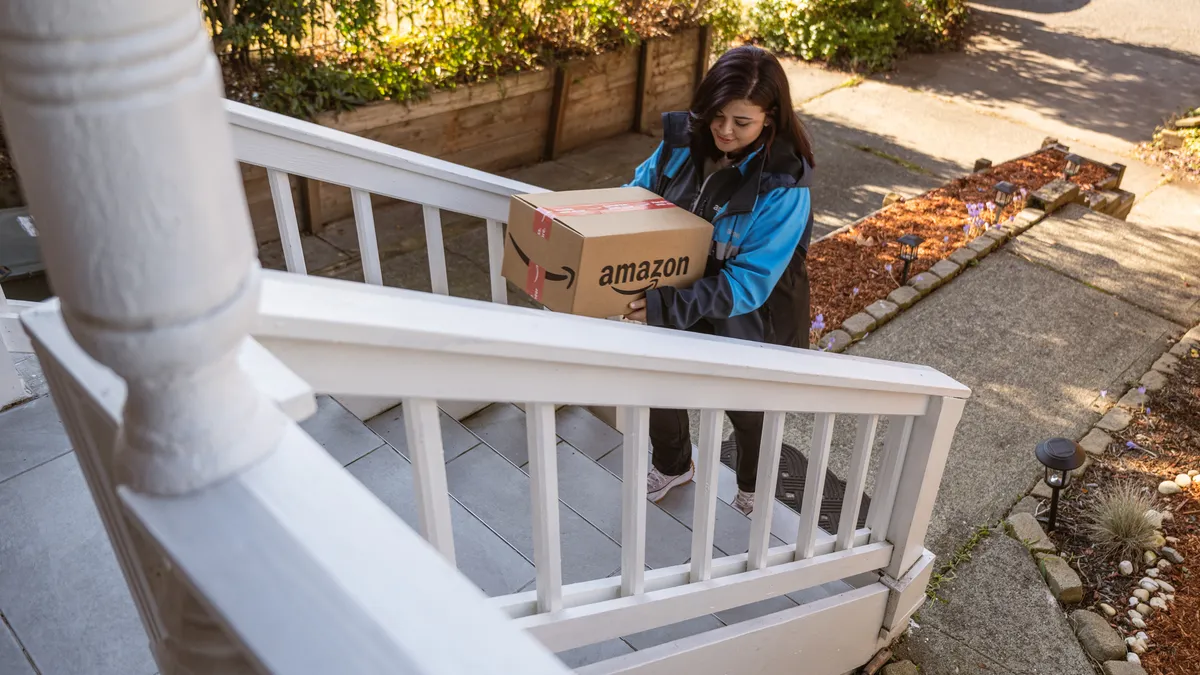Dive Brief:
- Amazon on Thursday said that July 11, the first day of its Prime Day sale, was the single largest sales day in its history. The e-commerce giant didn’t provide revenue numbers for the two-day event, but said Prime Day shoppers saved more than $2.5 billion worldwide, surpassing previous Prime Days.
-
It was a record event for U.S. e-commerce in general. Along with competing sales at other retailers, Prime Day this year helped push U.S. e-commerce up 6% year over year on July 11, and 6.4% on July 12, according to Adobe Analytics. Across both days, U.S. online sales rose 6.1% to $12.7 billon, Adobe found.
-
More than half of Prime Day shoppers said they purchased items they'd been holding off on buying until they were on sale, according to research from Numerator. Many stocked up on everyday essentials rather than buying larger ticket items, according to Numerator Analyst Amanda Schoenbauer.
Dive Insight:
Prime Day, open only to Prime members, has paved the way for summer sales across retail.
“Amazon had plenty of competition for Prime Day this year with both Target Circle Week and Walmart Plus Week happening simultaneously, giving consumers several options for the sales they shop," Koen Looijmans, executive vice president of Retail PX at Productsup, said by email. "Something that stands out, however, is that both Target and Walmart held longer sales (seven and four days) compared to Amazon’s sought-after two-day shopping extravaganza. Perhaps, as an attempt to capture customers who missed Amazon’s short window."
This year, over half of shoppers compared Amazon's prices with others before making a Prime Day purchase, Numerator found. About a third of Prime Day shoppers said they had or might shop Target’s similarly timed event and 33% said they would go to Walmart’s, while 37% said they wouldn't shop any other sales.
Although inflation is easing, consumers have been grappling with its effect on their wallets for some time now, making sales events handy for buying household essentials or already planned purchases. They’re also taking advantage of payment options. From July 11 to 12, shoppers used buy now, pay later for 6.5% of online orders, or $927 million in revenue, up 20% compared to last year, per Adobe. That serves as a preview for the upcoming holiday season, according to Vivek Pandya, lead analyst at Adobe Digital Insights.
“For months, consumers have felt the effects of persistent inflation and an uncertain economic environment, and it has pushed shoppers to embrace more flexible ways to manage their spending around the Prime Day event," Pandya said in a statement.
Expectations for curbside pickup could also be a factor this holiday season, considering that the service was used in 20% of online orders on July 12, up slightly from last year, Adobe found.
On Amazon, more than half of Prime Day items were under $20, and the average spend per item was $32.35, according to Numerator. Early on in the sale, top-selling items included Temptations Cat Treats, Fire TV Sticks and Liquid I.V. Packets.
While there are indications that many consumers leveraged the summer sales to stock up on essentials, others may also be shopping for back to school or even the holidays. Adobe found discounts in electronics that peaked at 14% off list price, with 12% for apparel, 12% for toys, 9% for home & furniture, 8% for computers, 7% for appliances, 6% for sporting goods and 5% for TVs. Per Numerator, shoppers’ top categories were home goods (28%), household essentials (26%), and apparel and footwear (24%).
Amazon said that merchants involved with its Buy with Prime program saw a sales bump during Prime Day. The program, piloted last year and expanded to all U.S. merchants in January, allows Prime members to shop on outside websites, using their saved checkout details and accessing Prime benefits like free delivery and returns. The company didn’t say how many Buy with Prime sellers participated in the annual sales event, but those that did experienced a 10-fold increase in daily Buy with Prime orders and an 8-fold increase in daily revenue from those orders, compared to the month before Prime Day was announced.














